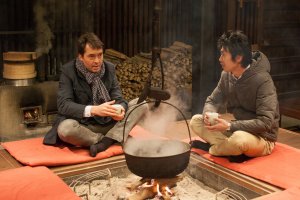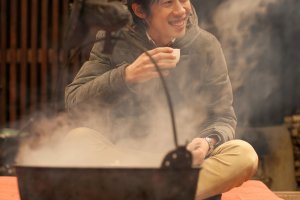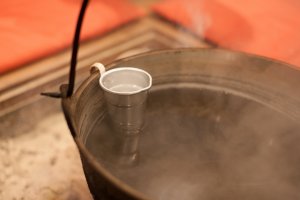Approaching KAI Alps on a pitch-dark December evening, fresh, thick snow crunching under my feet, I couldn’t help but feel I was looking at something out of a fairy-tale. The flaming torches burning bright at each side of the wooden gate and the soft, warm glow of lights from within the building stood in stark contrast to the snow-covered roof and the thick, glistening icicles hanging from the drainpipes. The cold evening air seeping in through my jacket, I wanted nothing more than to rush inside and immerse myself in one of the resort’s famous Japanese style hot-springs – or so I thought, until a sight outside the main door stopped me in my tracks.
Around an open fire with a metal pot hung over it, there sat a number of well-bundled guests blowing on cups of hot sake and tea and small plates of steaming food. This area, I was later informed by one of the many staff with excellent English, is called a ‘doma’ or traditional Japanese earthen-floored kitchen. Guests are free to fill their cups with tea or sake available in abundance on a nearby table, then heat them in the pot of boiling water hanging above the hearth. Furthermore, you are welcome to tuck into freshly-cooked locally sourced potatoes steamed in the’ kamado traditional Japanese oven, and top them with a generous helping of apple butter, which is also local produce. Despite being an open-air kitchen, the fire generated enough heat to keep the whole area cozy, and I gave into the temptation to linger outside for an hour or so before making my way into the lobby.
Not only is the kamado oven used to cook snacks for guests to nibble on as they chat and enjoy the night-time scenery, it is also used to boil the rice served as part of the extravagant breakfast that KAI Alps provides. Between the hours of 6 to 7 am, guests (or at least those who can manage to get up on time!) are free to observe the traditional Japanese way of preparing rice, which involves carefully monitoring the temperature and water-level inside the cooking pot, and adding or removing coals to the fire below as necessary. As I took in the brisk morning air, I felt very glad that I had managed to drag myself out of my cosy bed and take advantage of this rare opportunity. Rice is such a central part of Japanese culture, and watching this traditional method of cooking it gave me a little bit more insight into the complex history that lies behind such a seemingly-simple food. Though the rice, when served at breakfast, did not carry a smoky scent or flavor as I had expected, the texture and overall taste was discernibly different rice cooked in modern rice cookers and, despite the more than generous portion I was given, I couldn’t help going back for seconds.




































